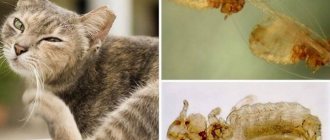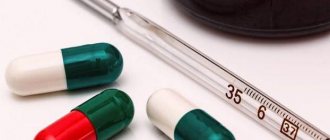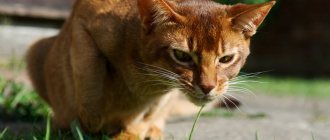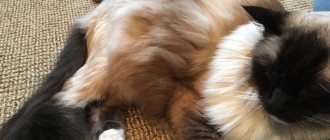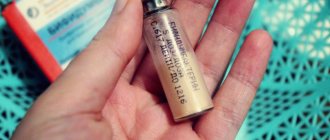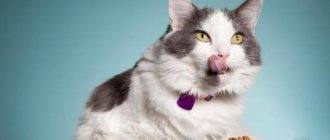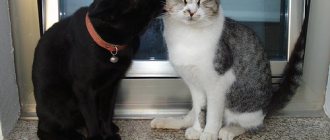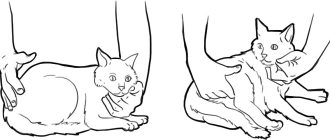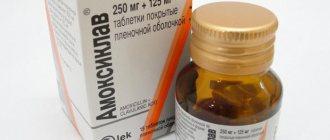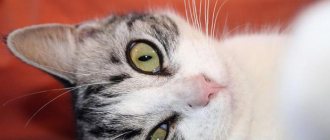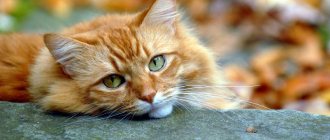The cat's digestive system has a number of unique properties that affect the process of digesting food. Like all mammals, the cat uses two main mechanisms for digesting food: mechanical - grinding food with teeth and chemical - breaking down food into nutrients that are absorbed into the blood through the walls of the small intestine. An equally important function of the digestive system is barrier function, i.e. preventing the penetration of harmful bacteria and viruses into the cat’s body. The complete digestion cycle—digestion, absorption of nutrients, and elimination of undigested food debris—occurs within 24 hours.
[
Oral cavity:
- biting and chewing;
- saliva consists of 99% water, 1% mucous substances (cats lack alpha-amylase);
- teeth are strong organs of the oral cavity that serve to capture and hold food, bite it, crush and grind it, as well as protect and attack.
Being a predator by nature, the cat gnaws, tears and cuts meat food with its teeth, after which it swallows it, practically without chewing. The salivary glands in a cat's mouth moisten food so it passes more easily down the esophagus into the stomach. Food already in the oral cavity begins to break down under the influence of saliva. This process is called mechanical digestion.
Sense organs
The sense organs are represented by a group of important components, which include: vision, smell, taste, hearing. The correct functioning of this system ensures the health of the cat, as well as survival in different conditions.
Visual
Cat eyes are the largest of all pets. Developed vision allows the animal to see not only small details and prey, but also navigate in the dark. The cornea protrudes forward, so the viewing angle is 250°.
Interesting! Experts have found that cats are able to distinguish up to 6 colors.
Auditory
Cats' hearing allows them to detect sound with a frequency of up to 65 kHz. The ear canal consists of 3 parts:
- Outer ear. This part is located on the pet’s head. With its help, sounds are captured and collected, and then transmitted to the eardrum.
- The middle ear transmits the signal from the membrane to the inner ear.
- The inner ear converts sound vibrations into nerve impulses.
Taste buds
Felines are able to distinguish almost all tastes, except sweet. Special papillae located on the tongue help recognize food. Each papilla contains about 30,000 taste buds.
Smell and touch
The sense of touch is accomplished through the whiskers. They are located in front of the pet's face. Animals are able to perceive 2 times more odors than humans. The main organ of smell is the nose. However, there is an additional organ on the upper palate - Jacobson's organ.
Interesting! A cat's nose has a unique imprint comparable to a human finger.
Stomach (food is retained and chemically processed)
- regulating the flow of food through the small intestine;
- secretion of gastric juices: gastric acid (creates an acidic environment in the stomach, favorable for the digestion of proteins);
- mucous substances to protect the walls of the stomach; pepsin (a substance that begins the process of protein breakdown);
- muscle activity (mixing food with gastric juice).
In the cardial part of the cat's single-chamber stomach there is the inlet of the esophagus, in the pyloric (or pyloric) part there is an opening leading to the duodenum. The convex upper part of the stomach near the cardiac part is called the fundus (vault) of the stomach. The largest section is the body of the stomach. The outlet section or pyloric (pyloric) part is the section of the stomach adjacent to the pyloric canal, which connects the lumen of the stomach with the lumen of the duodenum. The mucous membrane of the empty stomach is collected in longitudinal gastric folds. The outside of the stomach is covered with a serous membrane, which passes into the omentum, which connects the stomach with the ligament of the liver, esophagus and duodenum.
The mechanics of digestion are controlled by hormones secreted by the pancreas, thyroid and parathyroid glands. The pancreas produces the hormone insulin, which circulates in the blood and regulates the amount of glucose. The thyroid gland regulates metabolic rate. Its excessive activity is accompanied by increased heart rate, uncontrolled appetite and weight loss. The parathyroid glands, located on either side of the thyroid gland, produce a hormone to absorb calcium, which is necessary for muscle contraction.
The cat's digestive process is adapted to frequent consumption of food in small portions. In the cat's stomach, food is retained and undergoes chemical processing. The cardial part of the stomach produces gastric juices: acid that breaks down dietary fiber and enzymes that break down proteins - it is these enzymes that ensure the digestion of almost unchewed food. In addition, the stomach secretes mucus, which protects its walls and intestines from caustic enzymes. The stomach muscles aid digestion by regulating motility and allowing food to move into the small intestine.
Musculoskeletal system
The cat's body has two main types of muscles: smooth muscle and striated muscle. Smooth muscles are found in all the internal organs of the cat, and are directly connected to the autonomic nervous system, thereby ensuring the work and unconscious functioning of the internal organs, an excellent example of which would be the esophagus and the heart.
The striated muscles are attached to the skeleton and provide the cat with physical strength, the ability to move, hunt and fight. The striated muscles are familiar muscles that we can feel on the limbs and body of the pet.
An important part of the musculoskeletal system of a cat are tendons, ligaments and joints, which in all cats are distinguished by strength, flexibility and enviable elasticity until old age.
The cat's shoulder girdle, which has a unique structure, deserves special mention. Thus, in almost all mammals, the bones of the forelegs are connected to the body with the help of the collarbone, but in cats, the bones of the limbs are connected to the body exclusively with the help of muscles, which provides them with incredible mobility.
Small intestine:
- breakdown of proteins, fats and carbohydrates (including starch) using enzymes;
- carbohydrate absorption occurs less efficiently than in dogs (due to reduced amylase activity).
The cat's small intestine consists of a large number of loops and occupies a significant part of the abdominal cavity. According to its position, it is conventionally divided into three sections: duodenum, jejunum and ileum. The length of a cat's small intestine is about 1.6 m.
Veterinarian at home
The final stage of the digestive process occurs in the small intestine. As a result of contraction of the stomach muscles, food is mixed and pushed out in small portions into the duodenum. The duodenum receives enzymes from the pancreas, and bile from the gallbladder, which breaks down fats.
Digestion of food occurs throughout the small intestine, through the walls of which nutrients are absorbed into the blood and lymph.
The blood carries nutrients to the liver, the largest gland in the cat's body, which converts them into essential fatty acids and amino acids. Unlike a dog or a human, animal protein is needed to produce the full complex of cat liver acids: if the cat does not eat meat, it will die. The liver performs a barrier function, i.e. breaks down toxic substances and has a disinfecting function (prevents the penetration and spread of harmful bacteria and viruses).
A fibrous membrane divides the liver into left and right lobes. They are divided, in turn, into medial and lateral parts. The left medial lobe is relatively small, the left lateral lobe is significantly larger than it and covers most of the ventral surface of the stomach with one end. The right medial lobe is large; the gallbladder is located on its dorsal surface. At the base of the right lateral lobe there is an elongated triangular caudate lobe, in the anterior section of which there is a papillary process on the left, and a caudate process on the right.
One of the most important functions of the liver is the production of bile. The gallbladder is pear-shaped and located in the cleft of the right medial lobe.
The liver is supplied with blood through the hepatic arteries, the portal vein, and venous outflow occurs through the hepatic veins into the caudal vena cava.
Circulatory system
The circulatory system in cats works the same way as in other mammals: the heart pushes blood through arteries that have elastic walls and rhythmically carry out contraction and relaxation movements. It is thanks to such movements that arteries located close to the skin can be felt, and this is called the pulse. The cat's pulse is easiest to detect on the inside of the thigh, and in a healthy animal it should range between 100-150 beats per minute.
The cat's brain absorbs 15-20% of the blood, the muscular system absorbs up to 40% of the total blood, and about 25-30% of the blood goes to the internal organs. During physical activity, muscles can absorb up to 90% of the blood, which is why cats get tired so quickly, but can focus maximum strength for a short period of time.
The animal's heart is a hollow organ located in the chest, just behind the breastbone. An important nuance is the fact that the weight of a cat’s heart depends on their weight, and does not have clearly established standards. Most often, the heart of an animal weighs 0.6% of the total body weight. The cat's heart consists of 2 ventricles and 2 atria.
The cat has a double circulation. The main blood circulation is provided by capillaries and arteries connected to the heart, which connect to all internal organs. The second circle of blood circulation is provided by veins, which pump blood into the right ventricle of the heart, straight through the lungs and their arteries.
Cat blood has high clotting rates compared to humans, and it cannot be replaced with the blood of other animals, as this can lead to the death of the cat. The bulk of the blood is yellow plasma, 30-45% are red blood cells, and the rest is allocated to white blood cells and platelets. Cat blood has 3 groups: A, B, AB. Cat blood type AB is extremely rare, which should be taken into account by owners of such animals.
Features of feeding a cat at different stages of life
Preparation for mating
At this stage, a balanced daily diet is necessary. Excess weight can lead to a decrease in the number of kittens in the litter and problems with fertilization. Insufficient weight provokes exhaustion during feeding and insufficient lactation.
First trimester of pregnancy
Cats' needs increase linearly, from the first day until the end of pregnancy. It is recommended to use specialized food for pregnant and lactating cats.
Second and third trimesters
In the second week after mating, there may be a slight decrease in appetite. Maximum nutritional needs increase at 6-7 weeks (by 25-50%). In the last week before birth, needs decrease.
Childbirth
A complete refusal to feed a day before birth is the norm. It is important to provide sufficient water. On the first day after birth, it is recommended to offer cats diluted wet food.
Lactation - key points:
- Sufficient amount of water is required. Energy and nutrient requirements increase immediately.
- A sufficient amount of protein (at least 35% in dry matter, mainly of animal origin), fats (Omega-3) and calcium, energy requirements increase threefold.
- During lactation, the animal should not lose more than 5-10% of its normal weight.
Feeding kittens
As a rule, starting from the fourth week, the cat begins to avoid the kittens itself. Complementary feeding for kittens begins in the third or fourth week. From the sixth to eighth week, kittens are weaned. We start with ¾ of the daily norm, the last milk feeding in the morning, in three to four days we will transfer the daily norm to the full one. It is recommended that kittens be allowed to try and get acquainted with different types of food (dry, pate, pouch, natural products). This will subsequently help avoid noophobia (fear of new foods).
Features of nutrition after castration
Changes in metabolism after castration often lead to weight gain, especially with uncontrolled feeding. To prevent excess weight, it is recommended to increase your pet’s physical activity and reduce the caloric content of the diet.
Features of nutrition for seniors
Senior cats - from ten to twelve years old. The protein requirements of a senior cat are higher than those of young animals. Ready-made senior/light food is not suitable for all senior cats, as they do not always take into account concomitant diseases and pathologies that the pet develops in old age.
Skeleton and its parts
What a cat's body consists of can be found out through anatomy - a branch of biology that studies the structure of the body. First, you should get acquainted with the frame that holds all the important organs, that is, with the skeleton.
There are about 40 more bones in the cat skeleton than in the human skeleton, amounting to 244-250 pieces. The exact number depends on the length of the tail.
Skull and teeth
The cat's skull has 24 bones. 13 of them are on the facial part, and 11 are on the cranial part. Compared to other mammals, a cat's head is quite small in relation to its body, but it has a well-developed brain inside its skull.
The strong jaws of mustachioed pets have 30 sharp teeth. A smaller number (26) is typical only for kittens. By 7-8 months, their milk teeth are replaced by molars, and the dentition is replenished with missing molars.
Spine and tail
A cat's flexibility is due to the amazing mobility of its vertebrae. They can all be divided into 5 departments:
- cervical, consisting of the most massive bones;
- thoracic, to which 8 pairs of ribs are attached;
- lumbar, surrounded by muscles that hold the contents of the abdominal cavity;
- sacral, consisting of 3 fused vertebrae;
- caudal, including from 12 to 28 vertebrae.
Thanks to the massiveness of the cervical vertebrae, the animal can easily turn its head almost 180°, and thanks to its underdeveloped collarbones, it can easily penetrate the narrowest crevices.
The tail plays a special role. With its help, the cat maintains balance while jumping or falling from a height.
Four paws, and there are scratches on them
A cat's paw bones are not directly attached to the skeleton. They are held in place by muscles and tendons.
The hind limbs differ from the front limbs in being longer and having fewer fingers. There are as many of them in front as there are in humans, and in the back there are only 4.
Each of the fingers is equipped with a sharp claw. In a calm state, the claws are retracted into a special pouch, but when you press on the pad, they can be returned back. This is very convenient when trimming overgrown claws.
Due to the unusual location of the knee (right under the belly), cats always walk on tiptoe. This bizarre method of transportation is not only silent, but also very safe. When jumping, the paws absorb all the energy expended, so landing from a great height is soft and quiet.
